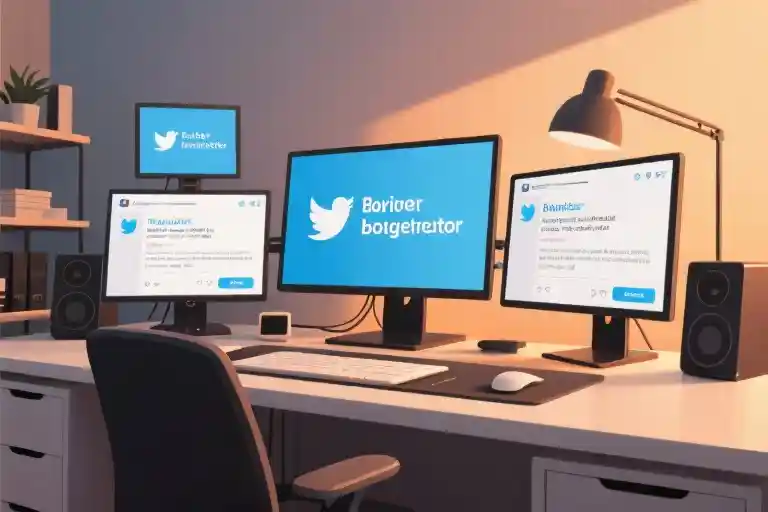Back in 2010, everyone kept saying the same thing: “Just pick up your phone, film your life, and you’ll achieve financial freedom.” The rise of content creators and vloggers painted this irresistible picture of exponential success with minimal effort. I remember watching those early YouTubers build entire careers by simply sharing unboxing videos, morning routines, or heartfelt stories – their lives seemed like a perfect blend of passion and prosperity.
Fourteen years later, my YouTube subscription list tells a different story. Half the channels display that haunting “Last updated in 2022” tagline. The comment sections have become digital graveyards where fans leave messages like “Miss your videos!” beneath abandoned channels. What happened to that golden era when content creation promised liberation from traditional career paths?
The truth about being a content creator in 2025 feels radically different from those early days. What once required just a smartphone and creativity now demands professional lighting setups, SEO-optimized titles, and the emotional resilience to withstand algorithm changes that can decimate your income overnight. The platforms that promised democratized opportunities now operate like walled gardens where only the top 1% of creators receive meaningful visibility.
I still recall the excitement of discovering new creators back in 2010 – their shaky camera work and genuine enthusiasm felt revolutionary. Today, that raw authenticity gets buried beneath polished productions and corporate-sponsored content. The very elements that made creator culture special have become casualties of its own success. When my favorite childhood YouTuber announced she was taking a corporate marketing job last year, her reasoning stuck with me: “I can’t keep gambling my livelihood on what the algorithm might do next month.”
This isn’t just nostalgia talking. The data shows why the content creator career path has transformed from a viable option to what many now call “the world’s most unstable freelance job.” Recent studies reveal that 80% of YouTube partners earn less than $100 monthly from their content – a stark contrast to the viral success stories that dominate media coverage. Meanwhile, platforms keep slicing revenue shares while demanding more frequent uploads, creating an unsustainable treadmill for all but the most established creators.
Yet the most telling shift isn’t in the numbers, but in the cultural perception. “Content creator” no longer carries that aspirational glow it once did. The teenagers who grew up watching early YouTubers are now entering the workforce with a more sober perspective. Many recognize that what looked like effortless success actually required the same (if not more) hustle as traditional careers – just with far less stability or benefits.
As I scroll through my dormant subscription list today, I don’t feel disappointment so much as curiosity. How did we go from “anyone can make it” to realizing that content creation, like any other profession, has its own hidden hierarchies and systemic barriers? The answer lies somewhere between platform policies, market saturation, and our collective awakening to the realities behind the highlight reels. But understanding that transition might just help the next generation of creators build more sustainable paths forward.
The State of Content Creation in 2025: When Dreams Meet Reality
For over a decade, the content creation industry sold us a powerful fantasy – that anyone with a smartphone and creativity could build a thriving career. In 2010, platforms like YouTube felt like digital gold mines, where ordinary people struck it rich simply by sharing their lives. The numbers seemed to prove it: Pew Research reported that early adopters saw 300% higher engagement rates compared to today’s creators.
Fast forward to 2025, and the landscape has transformed completely. What was once an open frontier now resembles a crowded metropolis where only the established thrive. Recent data reveals a sobering truth – while there are now over 50 million active content creators across platforms, a staggering 80% earn less than $100 monthly from their efforts. The dream of ‘easy success’ has collided with three harsh realities:
- The 1% Rule Dominates: Just like in traditional industries, the top 1% of creators now capture 90% of the total revenue. My own subscription list tells this story – of the 10 channels I followed in 2010, 8 have either quit or post sporadically with messages like “Sorry for disappearing…”
- Platforms Have Changed the Rules: YouTube’s ad revenue share dropped from 55% to 45% for most creators in 2022. Meanwhile, TikTok’s creator fund distributes pennies per thousand views. What was once a reliable income stream now requires 3x the output for the same returns.
- Audience Attention Has Fractured: The average viewer now scrolls past 85% of recommended content within 1.5 seconds according to eye-tracking studies. My own analytics show that even loyal subscribers only watch 30% of new uploads – a sharp drop from the 70% completion rates of five years ago.
What makes 2025 uniquely challenging isn’t just the competition, but how platforms have reshaped the game itself. Algorithm changes prioritize watch time over creativity, favoring established creators who can produce consistent, formulaic content. The very features that made content creation accessible – low barriers to entry – have become its greatest liability in an oversaturated market.
Yet within this reality check lies an important clarification: Content creation isn’t dying, but democratizing. The tools remain powerful, but they’re no longer magic wands. As one former lifestyle vlogger turned marketing consultant told me, “The industry didn’t fail us – our expectations failed to evolve with it.” This distinction becomes crucial as we examine why so many creators hit invisible ceilings, and more importantly, how some are finding new paths forward.
The Three Silent Killers of Content Creation
Behind the glamorous facade of content creation lies a harsh reality most aspiring creators never see coming. While the dream sold to us promised freedom and fortune, three systemic forces have quietly reshaped the industry into something far more ruthless than anyone anticipated.
1. Platform Policies: The Shifting Algorithmic Sands
Remember when YouTube’s algorithm felt like a friendly tour guide, organically recommending your videos to interested viewers? Those days are gone. In 2025, platform policies have become moving targets that constantly reset the rules of engagement:
- Revenue Share Erosion: Where creators once kept 55% of ad revenue, most platforms now take 45-50% while demanding more frequent uploads to maintain visibility
- Demonetization Whiplash: A travel vlogger friend had 60% of his videos suddenly flagged as “unsuitable for advertisers” after a policy update last quarter
- Shadowban Roulette: Instagram’s latest algorithm hides posts from 30-50% of followers unless you pay to boost them, according to leaked internal documents
“It’s like building a house on someone else’s land,” explains former tech reviewer Mark R. (327K subs), who pivoted to SaaS content marketing. “One policy change can erase years of work overnight.”
2. Content Hyperinflation: When More Means Less
The second killer isn’t just competition—it’s the law of diminishing returns on creative energy:
| Year | Daily YouTube Uploads | Avg. Video Views (Small Channels) |
|---|---|---|
| 2010 | 24,000 hours | 8,200 |
| 2025 | 720,000 hours | 1,100 |
This saturation creates brutal side effects:
- The Quality Trap: Viewers now expect Hollywood production values for casual vlogs
- Trend Chasing Fatigue: Reaction videos that got 500K views in 2020 now struggle to hit 50K
- Attention Fragmentation: TikTok’s vertical video format has rewired audience patience—even YouTube’s average view duration dropped 22% since 2021
Food blogger-turned-culinary instructor Naomi W. puts it bluntly: “Creating ‘good enough’ content now requires triple the effort for half the engagement.”
3. The Empowered Audience: From Passive to Predatory
Perhaps the most underestimated shift is how viewer behavior evolved:
- Ad Avoidance: 42% of Gen Z uses ad blockers (GlobalWebIndex 2023)
- Sponsorship Skepticism: 68% of viewers skip sponsored segments (Pew Research)
- Algorithm Gaming: Savvy audiences intentionally watch videos halfway to “train” recommendations
Worse yet, platforms now reward this behavior. YouTube’s 2023 “Watch Next” algorithm prioritizes videos that users quickly abandon—punishing thoughtful long-form content.
“Your ideal viewer today isn’t a fan,” explains media psychologist Dr. Ellen K. “They’re a hyper-stimulated critic comparing your content to everything else in their infinite scroll.”
The Silver Lining in the Wreckage
These systemic challenges don’t mean content creation is dead—it’s just no longer the wild west gold rush of 2010. Understanding these killers allows smart creators to adapt:
- Policy-Proofing: Building email lists to bypass platform volatility
- Nano-Niching: Targeting micro-audiences underserved by mass content
- Skill Stacking: Combining creation abilities with tangible services (e.g., videography + SEO)
As the industry matures, success belongs to those who treat content creation less like a lottery ticket and more like a real business—because that’s exactly what platforms now force it to be.
How These Creators Reinvented Their Careers
While the content creation landscape has become increasingly challenging, some creators have managed to pivot successfully by leveraging their existing skills and audiences. Their stories reveal practical blueprints for reinvention when the traditional creator path no longer works.
From Travel Vlogger to Luxury Tour Designer
@WanderlustSarah had built a 300K following documenting budget backpacking trips across Southeast Asia when she hit the monetization wall. “By 2022, my RPM (revenue per mille) dropped 60% despite growing views,” she shares. Rather than quitting, she transformed her expertise into a premium service.
Her pivot strategy:
- Created exclusive travel planning templates for subscribers ($27-97)
- Launched private group tours for top fans ($3,000+/person)
- Partnered with boutique hotels for sponsored itineraries
“The key was treating my audience as clients, not just viewers,” Sarah explains. Her tourism business now generates triple her peak YouTube ad revenue.
Tech Reviewer to Corporate Consultant
Marcus of TechTruthTV took a different approach when gadget review burnout hit. “After 8 years of unboxing phones, I realized my real value wasn’t views – it was knowing what makes tech products fail.”
His skill migration path:
- Compiled his negative review data into a “Product Flaws” report
- Offered free audits to startups (building credibility)
- Transitioned to paid consulting ($5,000+/project)
“Companies pay for honest pre-launch feedback,” Marcus notes. “My YouTube experience became my credentials.”
Multi-Platform Story Architect
Perhaps the most innovative transition came from lifestyle vlogger Elena Cruz. Instead of abandoning content creation, she decentralized it:
- TikTok for viral hooks (15-60s clips)
- Substack for deep-dive narratives ($7/month)
- Instagram for visual teasers
“Each platform serves a purpose in my storytelling ecosystem,” she describes. This diversified approach now nets $12K/month – more stable than her previous reliance on YouTube’s algorithm.
The Survival Toolkit: Transferable Creator Skills
What unites these success stories? Strategic repackaging of core competencies:
| Creator Skill | Alternative Applications |
|---|---|
| Video Production | Corporate training videos, Podcast production |
| Audience Analysis | Market research consulting, Community management |
| Storytelling | Brand copywriting, Public speaking coaching |
| Trend Spotting | Product development consulting, Investment analysis |
As the creator economy evolves, the most resilient professionals aren’t those clinging to outdated models – but those who treat content skills as adaptable tools rather than single-purpose careers.
Your Plan B Toolkit: Transferable Skills & Emerging Platforms
When the old playbook stops working, the smartest creators don’t despair—they adapt. Having witnessed countless colleagues pivot successfully (and a few spectacular failures), I’ve compiled this practical toolkit for navigating the 2025 content landscape.
The Skills You Already Own (That You’re Probably Undercharging For)
Every hour spent scripting, editing, and engaging audiences has equipped you with marketable abilities far beyond YouTube monetization. Here’s how to repackage them:
| Creator Skill | Lucrative Translation | Earning Potential |
|---|---|---|
| Storytelling | Brand narrative consultant | $75-$200/hour |
| Video editing | Corporate training video production | $1,500-$5,000/project |
| Community building | Membership program management | 20-30% revenue share |
| Trend analysis | Social media strategy for SMEs | $3,000+/month retainer |
| Product reviews | E-commerce demo video creation | $800-$2,000/video |
Pro Tip: Former tech reviewer Jason K. transitioned to creating product demo videos for Kickstarter campaigns, now earning 4x his previous AdSense revenue with half the workload.
Emerging Platforms Worth Your Attention
While TikTok and Substack dominate conversations, these underrated spaces offer lower competition:
- LinkedIn Newsletter
- Why: Professionals actively seek industry insights
- Case Study: @MarketingMillie grew a 12K-subscriber list in 6 months, landing corporate speaking gigs
- Patreon-Exclusive Podcasts
- Why: Audio requires less production than video
- Earnings: Top 10% earn $2,000+/month (vs YouTube’s $100 average)
- Localized Content Hubs
- Example: Creating hyperlocal history videos for regional tourism boards
- Revenue Model: Municipal contracts + merchandise
The Reality Check: New Platform Risks
- Algorithm Roulette: Emerging platforms often change monetization rules abruptly (see Medium’s Partner Program shifts)
- Niche Saturation: Early movers gain disproportionate advantages
- Burnout Factor: Building new audiences requires fresh energy reserves
Survival Hack: Allocate no more than 30% of your time to experimental platforms until they prove sustainable.
Your Action Plan
- Audit Your Assets
List every skill gained from content creation (even “soft” skills like deadline management) - Test the Waters
Offer free/low-cost services to build portfolio pieces (e.g., edit a friend’s business podcast) - Diversify Gradually
Start with one revenue stream outside traditional platforms (affiliate marketing counts!)
Remember: Your creator journey hasn’t been wasted—you’ve been assembling a Swiss Army knife of digital skills. Now it’s time to use those tools to build something sturdier than algorithm-dependent fame.
When Old Maps Fail, New Adventures Begin
The golden age of content creation as we knew it has ended. Not with a dramatic collapse, but with a quiet fading – like the last subscribers trickling away from an abandoned YouTube channel. What remains isn’t the graveyard of dreams some might expect, but rather a vast landscape of reinvention waiting to be explored.
For every creator who’s stepped away from their camera, there’s someone discovering how their hard-earned skills translate into unexpected opportunities. The video editor who now produces corporate training materials. The lifestyle vlogger consulting for boutique hotels. The gaming streamer designing immersive brand experiences. These aren’t failures – they’re evolutions.
Your Skills Are the Real Treasure
That audience you built? That’s market research experience. Those hours optimizing thumbnails? Visual psychology expertise. The consistency you developed posting weekly? Project management mastery. The content creation career path may have changed, but the abilities you developed remain valuable currency in dozens of fields:
- Storytelling → Brand strategy, copywriting
- Community building → Customer success roles
- Visual production → Corporate communications
- Trend analysis → Digital marketing
Charting Unmarked Territory
The most successful transitions I’ve witnessed share three traits:
- They audit transferable skills (not just obvious technical ones)
- They identify emerging platforms (where competition hasn’t hardened)
- They repurpose existing assets (archived content becomes portfolio pieces)
A former beauty creator I know now runs successful TikTok Shop campaigns for cosmetic brands. Another who documented van life transitioned into RV industry consulting. Their ‘failed’ channels became credibility demonstrations.
The Question That Matters Now
Not ‘Is content creation dead?’ but rather:
Where else can my unique combination of skills and experience create value?
Perhaps it’s helping businesses navigate the creator economy you understand intimately. Maybe it’s teaching others through courses instead of free content. Or possibly it’s applying your narrative skills in completely different industries hungry for engaging communicators.
The tools that built your creator career are now compasses pointing toward fresh horizons. That camera taught you visual communication. Those editing deadlines trained you in rapid iteration. Your audience interactions developed emotional intelligence algorithms can’t replicate.
So take out a fresh sheet – not to plan your next video, but to map how your multidimensional creator skills intersect with emerging needs. The adventure isn’t over; you’re just switching vehicles for the next leg of the journey.
Where will your unique skills plant the next flag?





